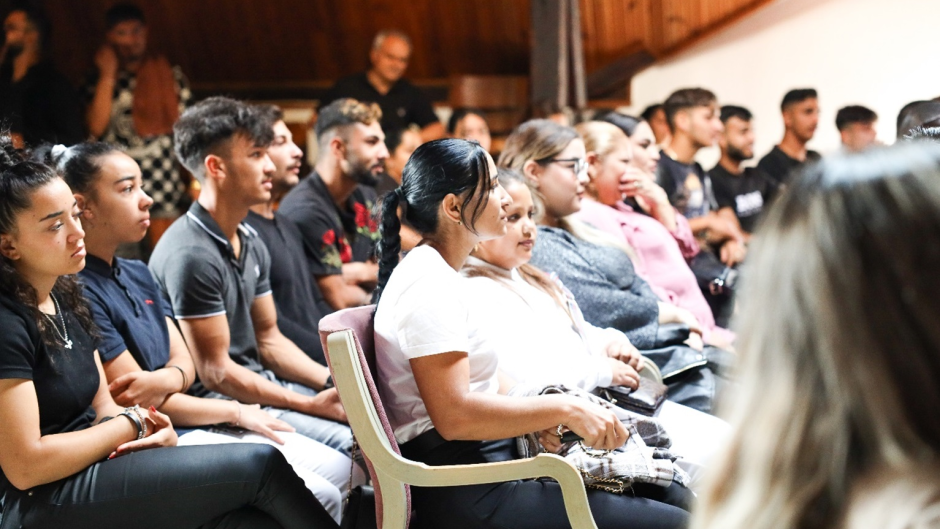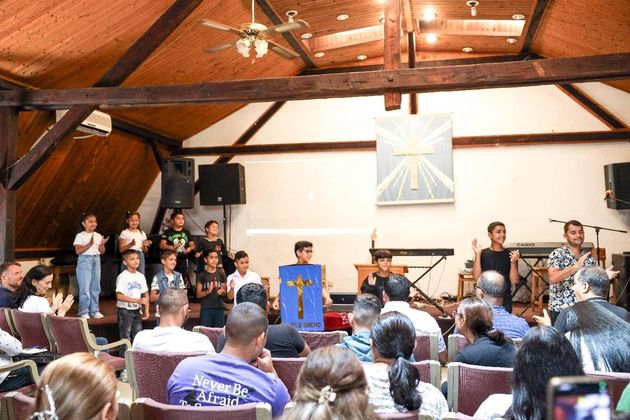Having the songs on YouTube is important for the creators. Roma people are avid users of their phones and social media. “Kids spend a lot of time on YouTube whether we like it or not”, says Misa.
 Around 80 Roma children’s workers together for a training on how to minister to children. / Photo: TWR
Around 80 Roma children’s workers together for a training on how to minister to children. / Photo: TWR
On a Saturday morning in September, around 80 Roma children’s workers from nine different Roma churches are gathered in a church building in the south of Serbia. They have come together for a training on how they can minister to children in their church with 20 original Roma children’s songs.
Having the songs is unique for those who are in children’s ministry in the Roma church. Prior to these songs, there were no recourses for ministering to Roma youth. There was no music, training or curriculum. With the songs, the vision of three Roma producers has come to life. It’s their desire to equip the next generation with the Word of God, letting God be the ultimate influence in their lives.
The original idea for the songs comes from Miki, a Roma pastor, and Nikola, a music producer. Both were born in Leskovac, Serbia, and are now serving in a Roma church in Jagodina, Serbia.
For Nikola, going into the production of Christian children’s songs was a big change. “Before I started producing Christian music I was involved in producing ‘worldly’ music,” says Nikola. “It was music that wasn’t glorifying God, but the Holy Spirit really worked on my heart, and I decided to quit doing this music. I really felt God calling me to start helping churches to make music that would glorify God.”
Nikola got connected with Miki and they discovered they shared a dream of creating music to the glory of God. They prayed together for a studio and God provided. Today, it’s a beautiful partnership between them, TWR and Ikonos Serbia.

The producers incorporated different musical styles for the songs, including jazz, pop, rock and a lot of oriental styles. The oriental styles are a reference to the cultural background of the Roma community. It’s a style they are familiar with.
The Roma originate from India, but in the 13th century a large group traveled to Europe and started settling in different countries. Today the communities are scattered across 30 countries.
Even though they are spread out, they are still connected with each other, and all have something in common. On some level, they are all discriminated against.
They struggle with low self-esteem because of too much prejudice and oppression. Churches in these communities bring a lot of change. They learn they are loved by Jesus and that they can find their identity in Him and are valued just like any other nation.
Bible contextualization is important for Roma people. They want to know the meaning of words and what God wants. To achieve this with the songs, the producers took Bible verses and turned them into songs. You can find a song about Jesus’ birth and about the story of David and Goliath.
Every song is supported by a music video, which is uploaded on YouTube. Some videos are animated, while others show the creators playing their instrument and singing. A few of the music videos allow kids to follow along with movements they can act out.
During the training a group of ten kids demonstrated the moves to one of the songs. The whole room engaged and nearing the end of the song more people were moving their hands.
Having the songs on YouTube is important for the creators. Roma people are avid users of their phones and social media, just like you and me. “Kids spend a lot of time on YouTube whether we like it or not,” says Misa. “But it’s also a great opportunity to fill the social networks with good content and give kids a way to grow in Christ. We want them to see something good on all these platforms”.
This way children’s ministry is not just something for Sunday but it’s something for the whole week.

[photo_footer]Still from one of the music videos./ TWR [/photo_footer]
The first ten songs were created by just three people. The wrote them together, played different instruments and sang the songs. It was a lot of hours spent in the studio after their normal working hours.
But they don’t limit their time because they love what they are doing. The other ten songs were a collaboration with more people involved.
With the first twenty songs just completed, the creators are thinking about the next steps. It’s their desire to one day create music, not just for children, but for the whole congregation.
They also want to add more musicians to the group of creators. They want to encourage other people to get involved and find their talents in music production to create songs for the Roma churches in Serbia and beyond.
Anna Laura Visser joined the Marcom department for TWR Europe and CAMENA in 2022 as the Graphic Designer and Content Specialist. Originally from the Netherlands she now lives in Bratislava, Slovakia.

Las opiniones vertidas por nuestros colaboradores se realizan a nivel personal, pudiendo coincidir o no con la postura de la dirección de Protestante Digital.
Si quieres comentar o